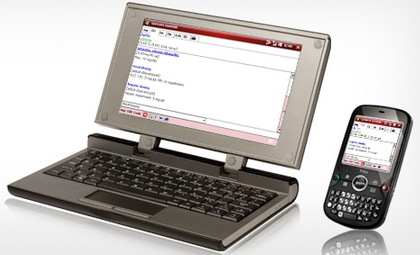
I was just reading a good review of the new Celio Redfly C8N terminal companion for Windows Mobile smartphones over on Brighthand…
Celio Redfly C8N Review
It looks like Celio listened to potential customers who told them their $500 price for the original model was way too high for a dumb terminal. The new C8N comes in at a more reasonable $299 (but still too high, IMHO). There’s also a smaller model for $229 (also too high). For $299 you get a dumb terminal that provides an 800×400 view into your Windows Mobile smartphone, a decent keyboard, and the ability (with an additional $20 cable) to watch videos from an iPod or Zune (or other media player).
If you spend another $40, you can get an Asus Eee PC 904 with a 1024×600 display, 1GB RAM, 160GB HD, and a 6-cell battery. It does not have Bluetooth. But, you can add one via a USB dongle very inexpensively or step up to another model like the Eee PC 1000H (what I use) for $479 and get a 10-inch display as well as Bluetooth. And, oh yes, it also has an SDHC card reader built in so I can read photos off my camera. And, wait, it has a 160GB hard drive so I can backup my photos while on the road. And, what’s this? 802.11n WiFi too? And since you can run Windows XP or Linux (or Mac OS X for that matter), I can use a real browser like Firefox instead of IE4 Mobile Minus for web browsing. And, yes, I can tether my Windows Mobile T-Mobile Dash smartphone to it either using Bluetooth or a USB cable.
It would make a lot more sense for Celio to become a software vendor that enables low-end netbooks like the Acer Aspire One ($329 for the flash storage-only, 3-cell battery model) to become Windows Mobile terminals. It would remove the all the issues surrounding hardware manufacturing and distribution and become a nimble firm with a use software product.
